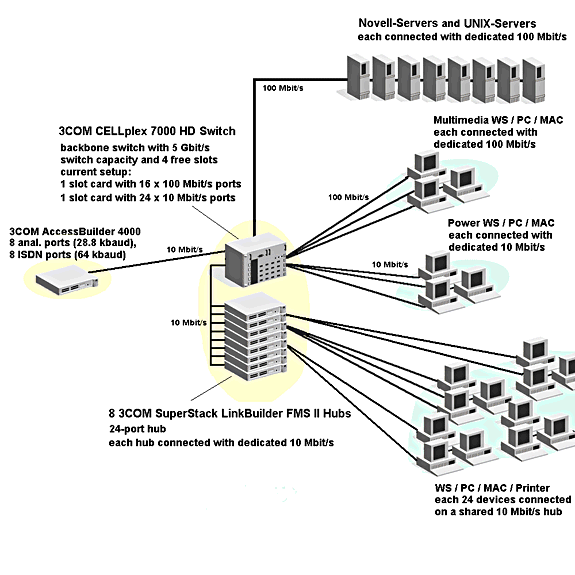|
home | introduction | research | people | facilities | events & news | visitor info | contact us | search |
|
Networking at the MPINetworking is one of the most important but also most dynamically changing areas in modern computer applications. This has to do with various phenomena which are well-known. At the MPI a heterogenous network is in smooth operation which allows us to interconnect all in-house computers, which gives the researcher access to the external world, and which enables employees to do teleworking from home. Therefore, this document gives some information about the various aspects of computer networking at the MPI:
Local Area NetworkUntil recently the institute had a flat Ethernet-based computer network with all well-known advantages and disadvantages. Due to faster desktop and server computers and due to the continuous increase of traffic this network started to form the main bottleneck for efficient computing. With the perspective that in the coming years the number of multi-media datastreams passing through the network would dramatically increase, the institute planned to build a new network infrastructure in 1997. Allthough it was known that ATM would best be suited to handle multi-media datastreams, the institute decided to base its new network on FastEthernet switching. Special servers and workstations will be connected to the net via dedicated 100Mbps lines to assure high throughput. The compactness of the institute building allowed us to concentrate all active network equipment into one room, therefore the cabling infrastructure was relatively easy to design. It is mainly built up from CAT 5 FTP cables. Fiber optic cables are installed between some crucial points. We don't see for the next years that we will need more than 155 Mbps to desktop computers. At the center of the new local area network infrastructure stands the ATM/FastEthernet switch (CELLplex 7000 HD) from 3COM. This is a modular switch based on cell-switching technology with a fast backplane of 5 Gbit/s for the switching fabric. This switch is currently equipped with FastEthernet and Ethernet switching modules.
Servers and multimedia-clients are connected to 100 Mbit ports. Other clients with higher demand on network throughput are connected to dedicated 10 Mbit ports. The large majority of clients (Workstations, PC's, MAC's, Printer) are connected via multi-port hubs, i.e. they share a 10 Mbit connection. This infrastructure gives us enough flexibility to grow with the user needs in the coming years. Wide Area ConnectivityThe institute participates in the network infrastructure of the University of Nijmegen. Currently, a FDDI-backbone is installed on the campus and the institute is connected to this backbone via a 10 Mbps line and an interface card in a router. In doing so, the institute participates in the 155 Mbps connection of the university to the Dutch network. Aspects of PC/MAC NetworkingAt the Max-Planck-Institute a local area network is available which connects almost all PC, MAC, UNIX-Workstations, and Servers with each other. Also most of the laser Printers are connected via the network. The logical UNIX network is based on TCP/IP. It allows the user to access all networking facilities. For a couple of reasons there is still a separate logical network based on IPX traffic. This network makes use of Novell Netware software. Powerful PC servers provide the necessary network services for the PC and MAC world and also give separate access to the network printers. The Novell servers also run gateway functionalities which provide the opportunity to share disks similar to NFS, to do IP-to-IPX protocol conversion, and to reduce the number of needed IP-addresses. On PC/MAC special emulation software is available which allows the user to run Xwindow based applications on PCs/MACs. Access via ISDNFor remote access services a remote access server (3COM AccessBuilder 4000) was installed, which provides a number of analog and ISDN connections. For PC-users at home the PPP protocol is supported which offers seamless access to the institute's resources from home. |
|
|
Last updated: February 13, 2000 12:06 |
|
|
|
|
